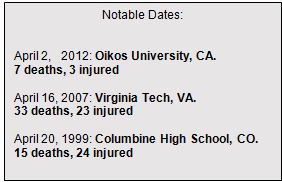
April to Become One of the Deadliest Months for Massacres
School administrators will have to take specific actions to better protect their students, staff, visitors and their campuses.
- By Patrick V. Fiel
- April 03, 2017
Have you heard the phrase “It is always calm before the storm?” It’s been a while since we had an active shooter event; I hope and pray that it will never happen again. Unfortunately, there is the lone wolf or wolves planning their next attack, the question is when and where will they strike again?
What have you done to prepare to mitigate your risks? When was the last time you spoke with a security expert? When was the last time you reviewed/updated your emergency crisis plans? When was the last time you had an all hazards assessment performed? When was the last time you tested your security solutions? When was the last time you had active shooter/incident training?
What can we do to prevent these types of incidents?
Work with a security consultant, in conjunction with local law enforcement, to complete a thorough risk assessment of your property or campus. The assessment:
Will be the initial phase to develop a course of action
All Businesses and Schools/Hospitals campuses are unique and have their own individual challenges
Pinpoints critical areas of vulnerability
Will identify the security strengths, as well as any security weaknesses
Process designed to reduce incidents
Help prioritize safety and security needs, and the use of limited resources
Helps re-tool existing crisis response plans to address the new threats
Could help minimize liability from lawsuits
Could help with funding

Have emergency/crisis plans and lockdown procedures in place. Train staff, hold safety/security drills with emergency responders, and practice responses to different emergency situations, e.g., Active Shooter.
Test your communication/access control systems frequently: PA system, phones, radios, duress buttons, fire alarms, and other devices. Cameras in and around have proven to be a strong deterrent, and very effective in helping to ensure policies and procedures are being followed, as well as in assessing incidents. They also provide a critical live insight for first responders during an emergency situation.
The combination of well-planned security procedures, risk assessments, crisis preparedness planning, security technology, and training can help to reduce incidents.
Let’s do something before it happens again. Unfortunately, the lone wolf or the copycats are making their plans.
“Tomorrow might be too late!”
About the Author
Patrick V. Fiel, Sr. is a national security consultant. He has over 35 years of experience managing law enforcement and security organization. He has served as the Public Safety Advisor for a large security integrator, Executive Director of Security for the Washington, D.C. Public School System, and is retired from the U.S. Army Military Police Corps. He can be reached at (910) 789-4265 or at [email protected].